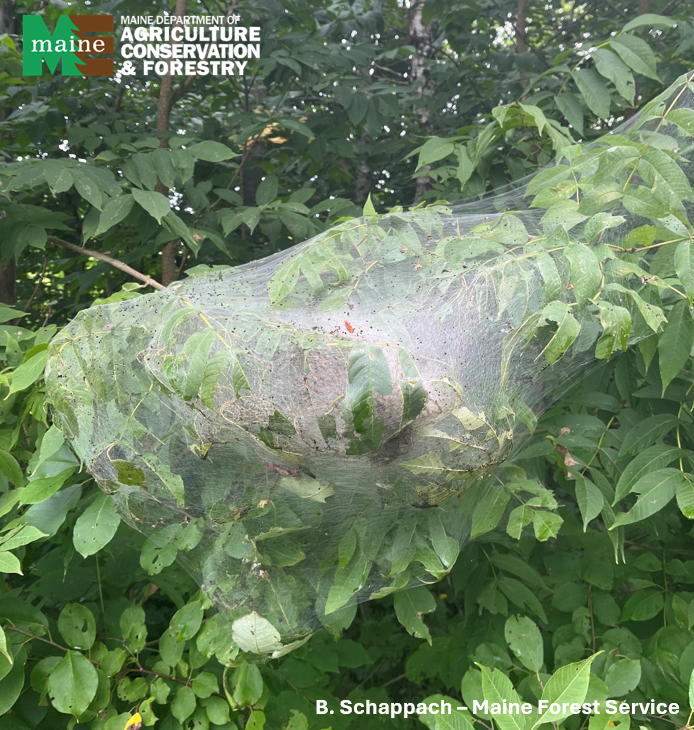Browntail Moth Update #12: August 16, 2024
Earlier this month, browntail moth caterpillars hatched from their egg masses and began chewing on their host leaves. At this life stage, the caterpillars are very small; only about a quarter inch in length. Newly hatched caterpillars are pale yellow in color, with a black head and two dark spots near their head (see photo below).
These young caterpillars will feed communally on host plants from now until the end of September or early October, depending on the weather. Damage from these caterpillars during this time of year is generally not a serious health issue for the plants. The browntail caterpillars will also start building their winter web for shelter through the coldest months, so you may start to see the formation of their winter webs.
Young browntail caterpillars hatch from an egg mass in Old Town, ME.
Because of the browntail caterpillars' small size, their mouths are not large enough to consume entire leaves. Instead, they graze on the outer surface of the leaf, which causes the leaf to die and turn a bronze or copper color. This damage is called skeletonization. When we perform our aerial browntail moth surveys in the late summer, we look for this copper colored damage in the trees to help identify where browntail moth populations are severe.
Browntail caterpillars skeletonize oak leaves in Dedham, ME. Note the copper color of an older feeding site on the right side of the oak leaf.
Although it is much less common this time of year, exposure to hairs from previous seasons’ caterpillars can still cause skin irritation. These exposures often happen during activities that stir up hairs in the environment during dry conditions such as performing yardwork or closing camp. Caterpillar hair exposure can also happen through contact with old pupal cocoons which are often still attached to host foliage/ sheltered areas, or surfaces on which hairs settled that have not been washed clean. The caterpillars currently feeding on the leaves are unlikely to cause a reaction in most people.
Our native fall webworm (Hyphantria cunea) are often mistaken for browntail moth caterpillars. Both insects are active in August and these caterpillars can be found eating the same host plants, and creating filmy silken webs. So how can you tell the difference?
-
(Carefully) Check the web!
- The size of the web - oftentimes, fall webworm webs will be larger than browntail webs during late summer (see photo below).
- The caterpillars on the web - if there are two dark spots toward the head of the caterpillar, these are likely browntail caterpillars. If these are not present, they are likely fall webworm caterpillars. Young browntail caterpillars also tend to be smaller (about a quarter of an inch) compared to fall webworm (often longer than a quarter of an inch).
-
Are there silk 'highways'? In late summer, browntail caterpillars will build white silk highways to help them travel in their host trees. In trees with fall webworm, although there is silk, they do not create readily observed trails. Instead, fall webworm caterpillars create large webs that oftentimes take up many leaves and branches on a tree.
 |
Webs created by fall webworm caterpillar, an insect native to Maine. These caterpillars do not cause rash in humans and are not a forest health issue. Fall webworm webs can get quite large, oftentimes taking up many leaves and branches in a tree. Browntail webs will not get this large - web size can be a good factor to determine which caterpillar is making webs on your property. Garland, ME.
Management of browntail moth in the late summer is limited, as pesticide treatments may not be effective and web removal can be difficult with crawling caterpillars. Instead, monitor your trees for active winter web creation throughout the fall to better understand which trees may need pruning or treatments. If you're not sure if you have browntail moth webs or fall webworm, you can always give us a call or send us photos so we can help determine the insect making the webs.
Pesticide treatment of browntail caterpillars in the summer is not recommended and may not be effective. Treatment of the very young browntail caterpillars can be difficult for a few reasons:
- Active skeletonizing of leaves from browntail in late summer can be difficult to detect and browntail are not always found on the same trees they defoliated in the spring (although this is possible in areas with high populations). If you can’t tell if there are newly hatched caterpillars in your trees, plan to observe them more closely over the winter and decide whether and how to treat them before spring. Please do not treat trees that do not have current signs of browntail (copper colored leaves from feeding).
- Caterpillars produce silk and feed under it, therefore, pesticides sprayed on leaves and other non-systemic pesticides may not be as effective.
- Trees in late summer may be less effective at absorbing and spreading trunk-injected pesticides throughout the tree’s leaves and therefore treatment may not be as effective.
Browntail populations appear to be spotty compared to previous years. We are looking for your reports of hatched browntail caterpillars or browntail egg masses from this current season! Your observations will help us understand where browntail moth is most active in the state right now. Please send reports to foresthealth@maine.gov. If you can, attach a photo from your phone and let us know when and where you took the photo. This will make it easier for us to confirm identity and track where populations are being reported.
Have other questions about browntail moth? Check out our extensive FAQ page for additional information and resources!
|